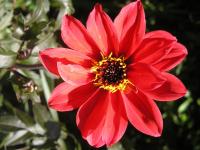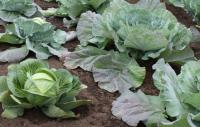Protecting Cabbages and Investigating a Peculiar Dahlia

Investigating the namesake of Dahlia 'Bishop of Llandaff' and how to spot the tell-tail signs of the Cabbage White Caterpillar before it's too late.
I love to find out about and investigate how different plants get their names. Many gardens are proudly displaying the Dahlia 'Bishop of Llandaff' at the moment (pictured.) I have not visited Cardiff for many years, but I understand that Llandaff is district of the Welsh capital, but which particular senior member of the Christian clergy and occupier of the Llandaff cathedral throne had a Dahlia named after them?
Dahlia ‘Bishop of Llandaff’ has foliage that is almost black. I wonder if this foliage colour resembles the gown of a clergyman? The black foliage beautifully compliments the semi-double Ferrari scarlet flowers which bloom from mid-summer and into autumn, maybe the flower colour bears some resemblance to the complexion of the real Bishop!
I would be very interested to learn more about the life and career of the Bishop that this Dahlia has been named after. If you can offer any information please contact us at plantadvice.co.uk.
The term Dahlia itself is a tribute to Andreas Dahl who was a Swedish Botanist, trained by the now legendary Linnaeus (1707-78). Linnaeus founded the latinised system of plant nomenclature which is still used today. The system classifies plants according to flower type and structure.
Plant breeders have well and truly left their mark on the world of Dahlias. There are only about 30 naturally occurring species, but somewhere in the region of 20,000 cultivated varieties! Many experts will recommend that Dahlias are lifted and stored in a frost-free environment during the winter months, but I think there are many Dahlias that are much hardier than suggested in the textbooks. I have seen them survive very hard winters in-situ, snuggled up under a thick duvet-like mulch. If you are not brave enough to try this method, dig them up and store after the first autumn frosts have damaged the foliage
Protecting your Cabbages
 If you enjoy homegrown brassicas such as cabbage, broccoli, calabrese and radish etc., there is a lot to be said for not taking a holiday at this time of year. If you are not careful, you could come home to find such vegetables decimated by the prolific Cabbage White caterpillars. I was caught out just by going away for a couple of days recently, had I stayed away any longer my broccoli crop would have been totally destroyed.
If you enjoy homegrown brassicas such as cabbage, broccoli, calabrese and radish etc., there is a lot to be said for not taking a holiday at this time of year. If you are not careful, you could come home to find such vegetables decimated by the prolific Cabbage White caterpillars. I was caught out just by going away for a couple of days recently, had I stayed away any longer my broccoli crop would have been totally destroyed.
There are two species of Cabbage White butterfly that are responsible for producing these ASBO deserving mini-munchers. They are Pieris brassicae (Large Cabbage White Butterfly) and Pieris rapae (Small Cabbage White Butterfly). The caterpillars of the Large Cabbage White are hairy and coloured black and yellow. The Small Cabbage White produces light green caterpillars covered in velvet-like hairs.
At plantadvice.co.uk we try and promote organic pest and disease control whenever possible. Green techniques are best used to try and control Cabbage White caterpillars. If you have enough time, I would recommend daily inspection of the affected plants, picking off the caterpillars and disposing of them as you wish. If you have young children, the timing is perfect; picking caterpillars off cabbages is a wonderful school holiday activity and an opportunity for you enhance their mini beast education.
If waiting for the first caterpillars to appear is cutting it a bit fine for you, when it comes to crop protection there are a couple of other options. The naked eye may be able to see the tiny yellow eggs that the female Cabbage White lays on the underside of the foliage. If you can see the eggs, just crush them by rubbing them off.
Rewinding the life-cycle process again, egg laying can be prevented all together by covering the crop with very fine netting or fleece from late spring onwards; preventing the female butterflies from landing on the foliage.
Other jobs I have been doing over the past couple of weeks:
- Using shears, trimming the varieties of Lavender that have just about finished flowering (I never do this until the bees have stopped visiting the flowers)
- Prune long vegetative shoots of Wisteria back to about 15cm long
- Collect Foxglove seeds (Digitalis) and sow to produce next year’s plants
- Avoid damage to tomato fruits by daily watering (sometimes twice daily in very hot weather)
Filed under General.

